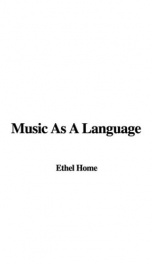Music As A Language

CONTENTS: - CHAPTER I. THE TRAINING OF THE MUSIC TEACHER - CHAPTER II. THE ORGANIZATION OF MUSICAL WORK IN SCHOOLS - CHAPTER III. THE TEACHING OF VOICE PRODUCTION AND SONGS - CHAPTER IV. THE SOL-FA METHOD - CHAPTER V. FIRST LESSONS TO BEGINNERS IN EAR-TRAINING - CHAPTER IX. An extra interest will thus be added to the lesson, and the. hild will have its first initiation into 'self-expression' through the art of music. - CHAPTER VI. THE TEACHING OF SIGHT-SINGING - CHAPTER VII. THE TEACHING OF TIME AND RHYTHM - CHAPTER VIII. THE TEACHING OF DICTATION - CHAPTER IX. THE TEACHING OF EXTEMPORIZATION AND HARMONY - CHAPTER X. THE TEACHING OF ELEMENTARY COMPOSITION - CHAPTER XI. THE TEACHING OF TRANSPOSITION - CHAPTER XII. GENERAL HINTS ON TAKING A LESSON IN EAR-TRAINING - CHAPTER XIII. THE TEACHING OF THE PIANO - CHAPTER XIV. SUGGESTIONS TO STUDENTS ON LEAVING A TRAINING DEPARTMENT *** a selection from CHAPTER X. THE TEACHING OF ELEMENTARY COMPOSITION: A wise musician has drawn attention to the fact that music has a more important educational function than any foreign language, being a common language for the expression of emotion, imaginative power, and rhythmic feeling. He went on to say that, as a training, it is of use from the very earliest years, and for all classes of the community. If we agree with this view-and it is encouraging to note the increasing number of those who do so-we must so organize the musical education of children that a time comes when they will be ready to 'express themselves' in music in the same way in which they can express themselves in their native tongue. An earlier chapter in this book has dealt with the teaching of extemporizing, first, treated as vocal expression, then as instrumental. When a class of children has arrived at the stage of being able to extemporize a tune of sixteen bars, in any given key and time, and introducing given modulations, it is quite ready to begin the more formal study of composition, and to be initiated into the mysteries of form. Hitherto the experiments of the class in this direction have been chiefly spontaneous; the teacher has of set design left the child who is extemporizing as free as possible, but the time has now come for a new 'window' to be opened in its mind. A preliminary talk should be given on the need of form in music. It must be pointed out that we cannot be intelligible without it, that it is not enough to have a language at our command; we must have shape in order to convey our ideas to others. The child should realize that the great artists in all the arts are under the same necessity as the youngest beginner in composition. Inspiration must be embodied in a definite form, or others cannot share the vision of beauty. For a time the child now has to learn to select a musical form, then to choose a musical thought which can be fitly expressed in it. It will seem a cramping process after the freedom of extemporizing, but the child who loves the work will willingly submit to the discipline. It cannot be too often impressed on the young teacher that children as a whole like discipline. They despise those who are indifferent to it, and give a ready submission to those who expect it, provided they feel sure of an underlying sympathy. The first lessons in form should consist of the analysis of simple tunes, preferably of the Folk Song type. The forms known as AB, ABA, and the variants derived from these will be explained, and the class will write examples of each, at first not harmonizing the melodies, but afterwards doing so. --This text refers to the Kindle Edition edition.
Info about the book
Author:
Series:
Unknown
ISBN:
0671316338
Rating:
3.5/5 (5)Your rating:
0/5
Languge:
English
Users who have this book
Users who want this book
What readers are saying
What do you think? Write your own comment on this book!
write a commentGenre
if you like Music As A Language try:
Other books by this author
Do you want to read a book that interests you? It’s EASY!
Create an account and send a request for reading to other users on the Webpage of the book!


